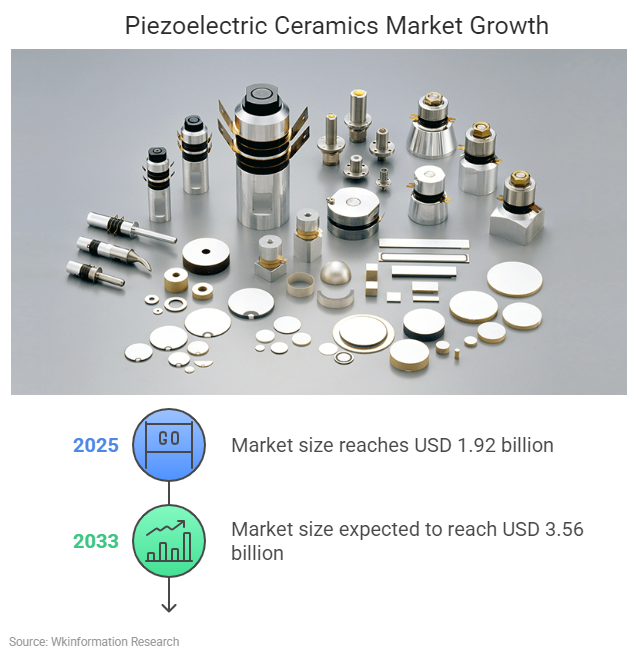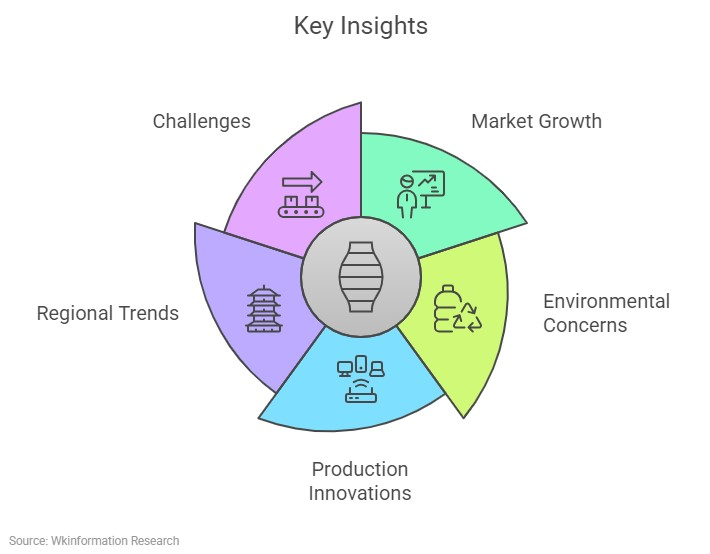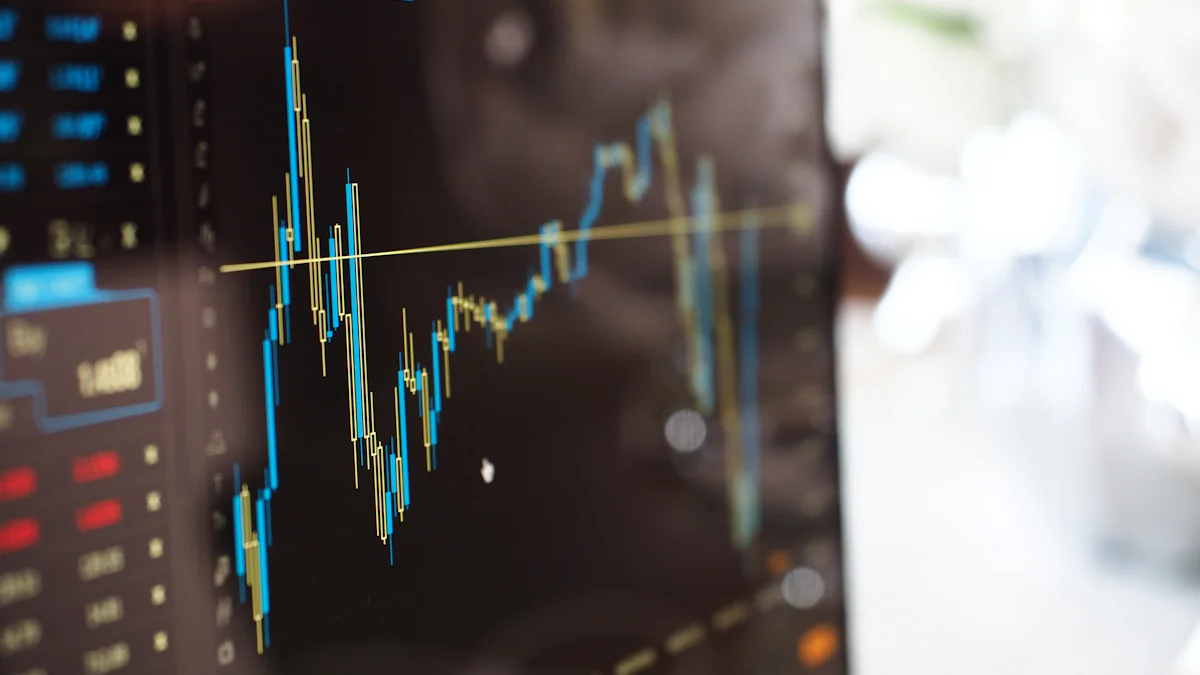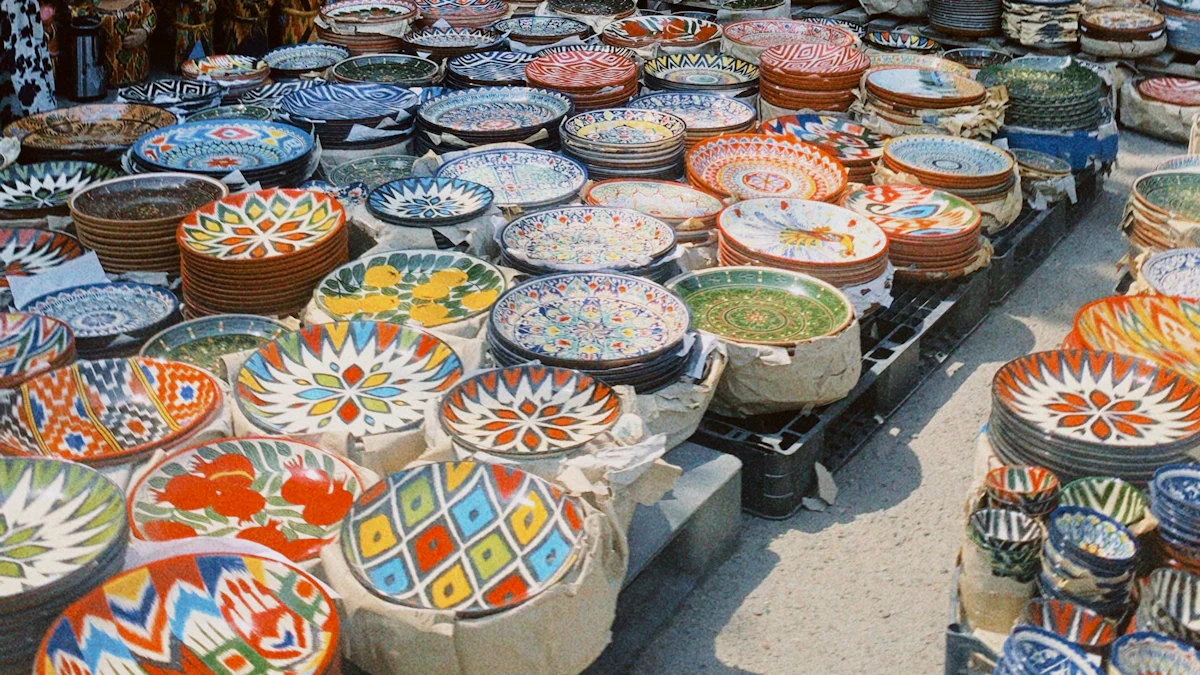
The piezoelectric ceramics market is undergoing significant transformation, driven by advancements in material science and manufacturing techniques. A notable trend is the shift toward lead-free ceramics, reflecting the growing demand for environmentally sustainable materials across industries like consumer electronics, automotive, and medical devices. Expanding applications in sensors, actuators, and electronic components further fuel market growth. However, challenges such as material brittleness and production consistency persist. Technological innovations, including advanced sintering methods, enhance efficiency and reduce costs. The market size will reach USD 1.92 billion in 2025 and is expected to reach USD 3.56 billion by 2033, with a CAGR of 8.02% from 2025 to 2033. Regional dynamics also play a pivotal role, with Asia-Pacific emerging as a growth hub due to industrialization and automation technologies.
Key Insights
- The piezoelectric ceramics market is growing fast. It may reach USD 3.56 billion by 2033 because of better technology and more use in many industries.
- Lead-free ceramics are important now due to environmental worries. They match global eco-friendly goals and follow strict rules.
- New ways to make ceramics, like 3D printing and better heating methods, help save money and make production faster.
- Asia-Pacific is the top region for piezoelectric ceramics. This is due to strong industry growth and new technology in China, Japan, and South Korea.
- Problems like fragile materials and uneven production must be fixed. Teamwork and new ideas can help the market keep growing.

Overview of the Piezoelectric Ceramics Market
Definition and Importance
Piezoelectric ceramics are specialized materials that generate an electric charge when subjected to mechanical stress. These ceramics play a critical role in modern technology, enabling the development of sensors, actuators, and transducers. Their unique properties make them indispensable in industries such as consumer electronics, automotive, aerospace, and healthcare. The ability to convert mechanical energy into electrical energy and vice versa has positioned piezoelectric ceramics as a cornerstone of innovation in energy-efficient devices and precision engineering.
Key Growth Drivers
Several factors contribute to the robust growth of the piezoelectric ceramics market:
- Advancements in the electronics industry have spurred demand for sensors, actuators, and transducers.
- The automotive sector increasingly relies on piezoelectric ceramics for components such as airbag sensors and fuel injectors.
- Aerospace technologies demand precision materials, further boosting the adoption of piezoelectric ceramics in actuators and sensors.
- Innovations in material science, particularly the development of lead-free piezoelectric ceramics, align with global sustainability trends.
These drivers highlight the pivotal role of piezoelectric ceramics in shaping the future of technology and industrial applications.
Challenges and Restraints
The piezoelectric ceramics market faces several challenges that hinder its growth and scalability. Limited material options restrict the development of advanced ceramics with improved performance. Manufacturers often struggle to achieve production consistency due to variations in material composition and processing techniques. These inconsistencies can lead to defects, reducing the reliability of the final products.
The inherent brittleness of ceramics presents another significant obstacle. This property makes piezoelectric ceramics prone to cracking and breakage, especially under mechanical stress. As a result, industries requiring durable materials may hesitate to adopt these ceramics for critical applications. High initial costs further complicate market entry for new players. The expense of raw materials, coupled with the need for specialized equipment, creates a high barrier to entry.
A lack of skilled professionals in the field limits the ability of manufacturers to scale operations effectively. Training and retaining a workforce with expertise in piezoelectric ceramics remain a persistent challenge. Supply chain disruptions also impact the market, increasing production costs and causing delays. These disruptions, often caused by geopolitical tensions or natural disasters, can destabilize the availability of essential raw materials.
Stringent environmental regulations impose additional restraints. Compliance with these regulations often requires costly modifications to production processes, particularly for manufacturers transitioning to lead-free ceramics. While these regulations align with sustainability trends, they add financial and operational burdens to the industry. Addressing these challenges will require innovation, investment, and collaboration across the sector.
Key Trends in the Piezoelectric Ceramics Market
Advancements in Material Science
High-Performance Ceramics
Recent advancements in material science have significantly enhanced the performance of piezoelectric ceramics. Researchers have demonstrated that reducing the thickness of lead zirconate titanate (PZT) discs from 0.7 mm to 0.2 mm can increase electrostrain from 0.3% to 1%. This improvement highlights the importance of geometrical dimensions in optimizing mechanical properties. Additionally, minimizing atomic defects has proven to enhance the efficacy of these materials, with polycrystalline lead-free piezoelectrics achieving electrostrain levels beyond 0.7%. These findings underscore the role of innovation in developing high-performance ceramics for diverse applications.
Lead-Free and Eco-Friendly Materials
The shift toward lead-free ceramics reflects growing environmental concerns. Lead-free alternatives not only comply with stringent regulations but also align with global sustainability goals. Surface grains in these materials deform more readily, improving strain performance and making them suitable for energy-efficient devices. This trend emphasizes the importance of eco-friendly solutions in the piezoelectric ceramics market.
Rising Demand in Consumer Electronics
Miniaturization in Electronics
The demand for compact and lightweight devices has driven the miniaturization of electronic components. Piezoelectric ceramics play a crucial role in this trend by enabling the development of smaller sensors, actuators, and transducers. These components are integral to modern consumer electronics, including smartphones and wearable devices, where space efficiency is paramount.
IoT Integration
The integration of Internet of Things (IoT) technology has further boosted the demand for piezoelectric ceramics. These smart materials enhance the functionality of IoT devices by providing precise sensing and actuation capabilities. The electronics and semiconductor segment continues to dominate the market, driven by the increasing adoption of IoT-enabled applications.
Expanding Automotive and Aerospace Applications
Sensors and Actuators
Piezoelectric ceramics have become indispensable in automotive and aerospace industries. Their applications include seat belt sensors, tire pressure sensors, and engine knock sensors. In aerospace, these materials are critical for actuators and sensors in aircraft systems, ensuring precision and reliability.
Electric and Autonomous Vehicles
The rise of electric and autonomous vehicles has amplified the need for piezoelectric ceramics. These materials are essential for components such as airbag sensors, fuel injectors, and engine control modules. In aerospace, advancements in unmanned aerial systems (UAS) and aircraft automation further highlight the growing reliance on these smart materials.
Growth in Medical Applications
Ultrasound Technology
Piezoelectric ceramics play a pivotal role in advancing ultrasound technology. These materials convert electrical signals into high-frequency sound waves, enabling detailed imaging for diagnostic purposes. Their precision and reliability make them indispensable in medical imaging devices, where accuracy is critical for detecting and monitoring health conditions. Beyond imaging, piezoelectric ceramics contribute to drug delivery systems by regulating medication release through mechanical motion conversion. This versatility highlights their importance in modern healthcare applications.
Wearable Medical Devices
The integration of piezoelectric ceramics into wearable medical devices has revolutionized health monitoring. These smart materials enable real-time tracking of vital signs, offering early detection of potential health issues. Wearable devices equipped with piezoelectric components provide continuous monitoring, enhancing patient care and reducing the need for frequent hospital visits. Their compact size and energy efficiency make them ideal for wearable technology, aligning with the growing trends in personalized healthcare solutions.
Focus on Energy-Efficient Sensors
The demand for energy-efficient sensors continues to grow across industries such as automation and healthcare. Piezoelectric ceramics have emerged as a cornerstone in meeting this demand, thanks to their ability to deliver precise sensing capabilities with minimal energy consumption. The rise of smart technologies and IoT applications has further propelled the adoption of these materials, as they enhance the functionality of connected devices.
Innovations in material science have driven the development of lead-free piezoelectric ceramics, offering environmentally friendly alternatives that align with global sustainability goals. These advancements improve the performance, sensitivity, and durability of sensors, making them suitable for high-tech applications. Additionally, improvements in manufacturing processes, including advanced sintering techniques and additive manufacturing, have optimized production efficiency. These methods reduce costs while maintaining the quality of piezoelectric ceramics, ensuring their viability for energy-efficient applications.
The adoption of 3D printing in the production of piezoelectric ceramics has also contributed to the creation of customized sensors. This approach allows for the precise fabrication of components tailored to specific applications, further enhancing their efficiency and functionality. As industries prioritize sustainability and innovation, the role of piezoelectric ceramics in energy-efficient sensors will continue to expand.
Market Share Analysis in the Piezoelectric Ceramics Market
Leading Industry Players
Overview of Major Companies
The piezoelectric ceramics market features several prominent players that drive innovation and competition. Key companies include Murata Manufacturing Co., Ltd., TDK Corporation, Kyocera Corporation, Morgan Advanced Materials, and CeramTec GmbH. Other notable contributors are CTS Corporation, Johnson Matthey, and Physik Instrumente (PI) GmbH & Co. KG. These organizations lead the market by offering diverse product portfolios and leveraging advanced technologies to meet evolving industry demands.
Strategies for Market Leadership
Major companies employ various strategies to maintain their leadership positions. Many focus on technological advancements to enhance product performance and operational efficiency. For instance, the integration of 3D printing technology allows manufacturers to create customized piezoelectric ceramics, reducing time-to-market and improving responsiveness to trends. Strategic partnerships and acquisitions also play a critical role. CTS Corporation’s acquisition of Ferroperm Piezoceramics in 2022 strengthened its presence in Europe and North America. Similarly, CeramTec’s launch of Rubalit ZTA in 2023 highlights the emphasis on product differentiation and innovation.
Competitive Landscape
Market Fragmentation and Consolidation
The piezoelectric ceramics market is highly competitive, with a mix of established players and emerging companies. While some firms focus on niche applications, others aim for broader market coverage. This fragmentation fosters innovation as companies strive to differentiate their offerings. However, consolidation is also evident, as mergers and acquisitions reshape the competitive landscape. These activities enhance market stability and drive the development of advanced products.
Impact of Mergers and Acquisitions
Mergers and acquisitions significantly influence the market’s evolution. For example, CTS Corporation’s acquisition of maglab AG in 2023 expanded its capabilities in automotive applications, particularly for electric vehicles. Such moves not only consolidate market positions but also foster innovation by combining expertise and resources. These developments are expected to propel the market forward, particularly in high-demand sectors like automotive and healthcare.
Regional Market Share Distribution
Asia-Pacific Dominance
Asia-Pacific holds the largest share of the piezoelectric ceramics market. The region’s dominance stems from its robust manufacturing base and technological advancements. Countries like China, Japan, and South Korea lead in innovation, driving demand across industries such as consumer electronics and automotive.
Growth in North America and Europe
North America and Europe also contribute significantly to the market. North America benefits from advanced healthcare and aerospace sectors, while Europe emphasizes sustainability and energy-efficient technologies. Both regions showcase steady growth, supported by investments in research and development and the adoption of eco-friendly practices.
Industry Innovations and Applications

Breakthrough Technologies
Innovations in Manufacturing
Recent advancements in manufacturing processes have revolutionized the piezoelectric ceramics industry. The development of lead-free materials has emerged as a sustainable alternative to traditional lead-based ceramics. Advanced sintering techniques, such as microwave-assisted and high-pressure sintering, have significantly improved production efficiency. Automation in production lines has enhanced consistency and minimized human error, ensuring higher-quality ceramics at reduced costs. These innovations have streamlined manufacturing, making piezoelectric ceramics more accessible for diverse applications.
Multilayer Ceramics Development
The evolution of multilayer ceramics has opened new possibilities for high-performance devices. By stacking multiple ceramic layers, manufacturers achieve enhanced electrical properties and compact designs. This approach is particularly beneficial for miniaturized components in consumer electronics and medical devices. Multilayer ceramics also exhibit improved durability and temperature stability, making them suitable for demanding environments like aerospace and automotive sectors.
Emerging Applications
Renewable Energy Systems
Piezoelectric ceramics are playing a pivotal role in renewable energy systems. These materials enable energy harvesting technologies in aerospace and defense, converting mechanical vibrations into usable electrical energy. Smart sensors and smart skin equipped with piezoelectric ceramics enhance situational awareness in critical operations. Additionally, autonomous power sources for low-power electronics and energy harvesting for smart combat suits highlight the growing reliance on these materials in sustainable energy solutions.
Defense and Security
In defense, piezoelectric ceramics contribute to vibration control systems and structural health monitoring. These applications improve the reliability and safety of military equipment. The shift toward non-lead piezoelectric materials aligns with sustainability goals while maintaining high performance. These advancements underscore the importance of piezoelectric ceramics in modern defense strategies.
Research and Development
Investment Trends
Research and development efforts in the piezoelectric ceramics market focus on enhancing material properties and manufacturing processes. Investments aim to improve sensitivity, durability, and temperature stability. Advanced sintering techniques and automation optimize production costs and scalability. The development of lead-free ceramics remains a priority, reflecting the industry’s commitment to environmental sustainability.
Academia-Industry Collaborations
Collaborations between academia and industry have driven significant advancements in piezoelectric ceramics. For instance, researchers at the Indian Institute of Science (IISc) and the European Synchrotron Radiation Facility (ESRF) demonstrated that reducing the thickness of ceramic materials enhances their performance. Such partnerships foster innovation by combining academic research with practical industry applications, accelerating the development of cutting-edge technologies.
Regional Insights in the Piezoelectric Ceramics Market

Asia-Pacific: The Growth Leader
Key Regional Drivers
The Asia-Pacific region leads the piezoelectric ceramics market due to its robust industrial base and technological advancements. Rising demand in healthcare, automotive, and manufacturing sectors drives growth. The emergence of smart solutions and a focus on sustainability further contribute to the region’s expansion. Additionally, the adoption of automation and energy-efficient technologies enhances the market’s trajectory. These factors position Asia-Pacific as a pivotal player in the global piezoelectric ceramics industry.
Role of China, Japan, and South Korea
- China dominates the market with its strong manufacturing sector and rapidly evolving technology industry.
- South Korea excels in electronics and robotics, supported by government initiatives fostering innovation.
- Japan emphasizes advanced applications in healthcare and aerospace, reflecting its commitment to technological progress.
East Asia, encompassing these nations, benefits from advanced technology adoption and significant consumer spending, solidifying its leadership in the market.
North America: Innovation and Growth
U.S. Technological Advancements
North America plays a crucial role in driving innovation within the piezoelectric ceramics market. The United States leads in research and development, focusing on energy-efficient technologies and advanced medical devices. Companies in the region prioritize product innovation and sustainable practices, ensuring competitiveness in a dynamic market. These efforts enhance the region’s position as a hub for technological breakthroughs.
Automotive and Aerospace Growth
The automotive and aerospace sectors in North America significantly contribute to the demand for piezoelectric ceramics. Applications in electric vehicles, autonomous systems, and aircraft components highlight the material’s importance. The region’s focus on precision engineering and high-performance materials aligns with the growing need for advanced piezoelectric solutions.
Europe: Sustainability Focus
Lead-Free Ceramics Adoption
Europe prioritizes the development of lead-free piezoelectric ceramics to meet environmental standards. Manufacturers focus on enhancing sensitivity, durability, and temperature stability to cater to high-tech applications. This shift aligns with the region’s commitment to sustainability, ensuring compliance with stringent regulations while advancing technological capabilities.
Government Support and Regulations
Favorable government policies and subsidies in Europe create a supportive environment for sustainable products. EU regulations, including migration limits for lead and cadmium, drive the adoption of lead-free ceramics. Additional national requirements, such as those in France, impose stricter limits on metals, further encouraging innovation in eco-friendly materials.
Emerging Markets
Opportunities in Latin America
Latin America presents significant opportunities for the piezoelectric ceramics market. The region’s increasing investments in infrastructure projects drive demand for advanced materials like piezoelectric ceramics. These materials enhance the performance of sensors and actuators used in construction and industrial applications. The rise of consumer electronics in countries such as Brazil and Mexico further fuels market growth. Manufacturers are leveraging the growing demand for compact and efficient electronic components to expand their presence in the region.
Niche applications are also emerging as a promising avenue for piezoelectric ceramics. Smart sensors, for instance, are being utilized in agricultural technology to improve crop yields through precise monitoring of soil and environmental conditions. Additionally, environmental monitoring systems equipped with piezoelectric sensors are gaining traction. These systems enable accurate data collection and quality control, addressing the region’s increasing focus on sustainability.
| Opportunity Type | Description |
|---|---|
| Infrastructure Investments | Increasing investments in infrastructure are driving demand for piezoelectric ceramics. |
| Consumer Electronics Growth | The rise in consumer electronics is creating new applications for these materials. |
| Niche Applications | Specific applications in agricultural technology and environmental monitoring are emerging. |
- Smart sensors enhance agricultural yields through precise monitoring.
- Environmental monitoring systems use piezoelectric sensors for quality control and data collection.
Growth in the Middle East and Africa
The Middle East and Africa (MEA) region exhibit strong growth potential for the piezoelectric ceramics market. Infrastructure development remains a key driver, with governments investing heavily in smart materials for new construction projects. Piezoelectric ceramics, known for their durability and efficiency, are increasingly integrated into sensors and actuators for these projects. This trend aligns with the region’s focus on modernizing urban infrastructure and adopting advanced technologies.
The energy sector also plays a pivotal role in the market’s expansion. Oil and gas operations in MEA are utilizing piezoelectric systems to enhance data collection and monitoring processes. These systems improve operational efficiency and ensure safety in challenging environments. The adoption of piezoelectric ceramics in renewable energy projects further underscores their importance in the region’s energy transition efforts.
The MEA region’s commitment to innovation and sustainability positions it as a growing market for piezoelectric ceramics. These factors, combined with the region’s strategic investments, create a favorable environment for market expansion.
Overview
The piezoelectric ceramics market continues to evolve, driven by advancements in material science and expanding applications across industries. Key trends, such as the shift toward lead-free ceramics and the integration of IoT, underscore the industry’s focus on sustainability and innovation. Regional growth drivers, particularly in Asia-Pacific, highlight the importance of technological adoption and industrialization.
Future opportunities lie in sectors like electronics, automotive, and aerospace, where demand for precision materials remains strong. However, challenges such as material fragility and production consistency require innovative solutions. With a projected CAGR of 8.02% from 2025 to 2033, the industry holds significant potential for growth and transformation.
| Report Metric | Details |
|---|---|
| Report Name | Global Piezoelectric Ceramics Market Report |
| Base Year | 2024 |
| Segment by Type |
· Lead Zirconate Titanate (PZT) · Lead Magnesium Niobate (PMN) · Others |
| Segment by Application |
· Industrial &Manufacturing · Automotive · Consumer Electronics · Medical · Military · Others |
| Geographies Covered |
· North America (United States, Canada) · Europe (Germany, France, UK, Italy, Russia) · Asia-Pacific (China, Japan, South Korea, Taiwan) · Southeast Asia (India) · Latin America (Mexico, Brazil) |
| Forecast units | USD million in value |
| Report coverage | Revenue and volume forecast, company share, competitive landscape, growth factors and trends |
FAQ
What are piezoelectric ceramics, and why are they important?
Piezoelectric ceramics are materials that generate an electric charge when subjected to mechanical stress. They are essential for creating sensors, actuators, and transducers used in industries like healthcare, automotive, and aerospace. Their ability to convert energy makes them vital for precision engineering and energy-efficient devices.
How does the market address environmental concerns with piezoelectric ceramics?
The industry focuses on developing lead-free ceramics to comply with environmental regulations. These eco-friendly alternatives align with global sustainability goals while maintaining high performance. Manufacturers also adopt advanced production techniques to reduce waste and improve energy efficiency during manufacturing processes.
Which industries drive the demand for piezoelectric ceramics?
Consumer electronics, automotive, aerospace, and healthcare industries lead the demand. Applications include sensors in vehicles, actuators in aircraft, ultrasound devices in healthcare, and components in IoT-enabled electronics. These sectors rely on piezoelectric ceramics for their precision, durability, and energy efficiency.
What challenges do manufacturers face in producing piezoelectric ceramics?
Manufacturers encounter issues like material brittleness, production inconsistencies, and high initial costs. Limited material options and stringent environmental regulations further complicate production. Addressing these challenges requires innovation in material science and manufacturing processes.
Why is Asia-Pacific a dominant region in the piezoelectric ceramics market?
Asia-Pacific dominates due to its strong manufacturing base, technological advancements, and industrial growth. Countries like China, Japan, and South Korea lead in innovation and production. The region’s focus on automation and energy-efficient technologies further drives its market leadership.
Global Piezoelectric Ceramics Market Report (Can Read by Free sample) – Table of Contents
Chapter 1: Piezoelectric Ceramics Market Analysis Overview
- Competitive Forces Analysis (Porter’s Five Forces)
- Strategic Growth Assessment (Ansoff Matrix)
- Industry Value Chain Insights
- Regional Trends and Key Market Drivers
- Piezoelectric Ceramics Market Segmentation Overview
Chapter 2: Competitive Landscape
- Global Piezoelectric Ceramicsplayers and Regional Insights
- Key Players and Market Share Analysis
- Sales Trends of Leading Companies
- Year-on-Year Performance Insights
- Competitive Strategies and Market Positioning
- Key Differentiators and Strategic Moves
Chapter 3: Piezoelectric Ceramics Market Segmentation Analysis
- Key Data and Visual Insights
- Trends, Growth Rates, and Drivers
- Segment Dynamics and Insights
- Detailed Market Analysis by Segment
Chapter 4: Regional Market Performance
- Consumer Trends by Region
- Historical Data and Growth Forecasts
- Regional Growth Factors
- Economic, Demographic, and Technological Impacts
- Challenges and Opportunities in Key Regions
- Regional Trends and Market Shifts
- Key Cities and High-Demand Areas
Chapter 5: Piezoelectric Ceramics Emerging and Untapped Markets
- Growth Potential in Secondary Regions
- Trends, Challenges, and Opportunities
Chapter 6: Product and Application Segmentation
- Product Types and Innovation Trends
- Application-Based Market Insights
Chapter 7: Piezoelectric Ceramics Consumer Insights
- Demographics and Buying Behaviors
- TargetAudience Profiles
Chapter 8: Key Findings and Recommendations
- Summary of Piezoelectric Ceramics Market Insights
- Actionable Recommendations for Stakeholders


